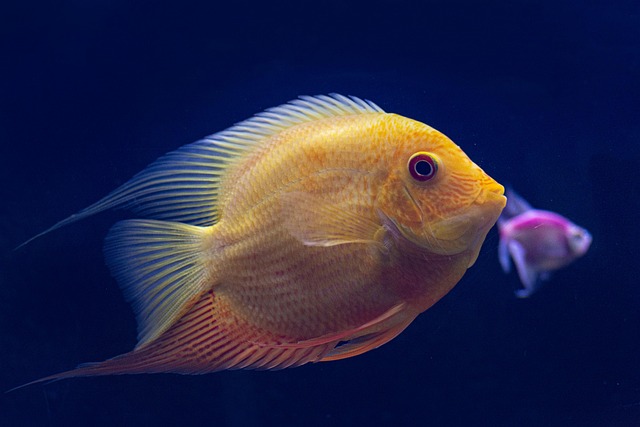Aquascaping transforms aquariums into artistic displays, blending design, planting, and features to mimic natural ecosystems. Biotopic accuracy ensures habitat health and visual appeal, while stylistic choices range from naturalistic to minimalist. Plants like Anubias and Bacopa offer both beauty and function, with decorations enhancing depth and texture. LED technology and lighting effects create captivating underwater scenes, fostering a deeper connection with marine environments in these artistic aquarium exhibits.
Unleash your creativity with innovative aquascaping techniques and transform your aquarium into a stunning marine landscape. This guide explores the art of designing aquatic ecosystems, from understanding principles and styles to selecting impactful plants and decorations. Discover the power of lighting and effects to enhance your aquarium exhibits, creating a vibrant, harmonious underwater world that captivates and inspires.
Unlocking Creative Potential: Aquascaping Techniques
Aquascaping is an art form that allows hobbyists and professionals alike to unlock their creative potential within the confines of an aquarium exhibit. By combining innovative design, strategic planting, and careful selection of aquatic features, it’s possible to create breathtaking underwater landscapes that mimic natural ecosystems. Techniques such as layering, contouring, and rockwork placement not only enhance visual appeal but also provide essential habitats for fish and other marine life.
In recent years, advancements in aquascaping have led to the development of unique styles like biotopic aquariums, which aim to replicate specific ecological zones, and minimalist designs that emphasize clean lines and delicate textures. These approaches cater to diverse aesthetic preferences while ensuring a balanced and sustainable aquatic environment. The art of aquascaping continues to evolve, pushing the boundaries of what’s possible in aquarium exhibits worldwide.
Designing Aquatic Ecosystems: Principles and Styles
Aquatic ecosystems, or aquarium exhibits, are not just containers for fish; they’re living, breathing works of art designed to replicate and enhance natural habitats. When crafting these underwater landscapes, several key principles guide aquascapers. One fundamental is biotopoic accuracy, aiming to mirror the unique characteristics of a specific ecosystem, from substrate composition to flora and fauna native to that region. This authenticity not only supports the health of the inhabitants but also creates a visually stunning display.
Style plays an equally important role in aquascaping. Popular aesthetics include naturalistic, minimalist, and creative abstract designs. Naturalistic aquariums strive for a lifelike representation of a particular environment, while minimalists opt for clean lines and simple layouts to highlight the beauty of the aquatic elements. Abstract styles take a more artistic approach, bending rules to create eye-catching compositions that defy conventional expectations of what an aquarium should look like.
Choosing Plants and Decorations for Impact
Creating an awe-inspiring aquarium exhibit involves a strategic selection of plants and decorations that work in harmony to produce a stunning marine landscape. When choosing plants, consider both aesthetic appeal and functionality. Popular options include live plants known for their vibrant colors and intricate shapes, which not only add visual interest but also provide hiding spots and habitats for aquatic creatures. For example, Anubias and Bacopa are popular choices due to their adaptability and striking appearances.
Decorations play a crucial role in enhancing the overall design. From intricately carved wooden structures to elegant rocks and cave formations, these elements can transform a basic aquarium into an immersive ecosystem. Opt for decorations that complement the chosen plants and the desired theme of your aquarium exhibit. Incorporating diverse textures and heights creates depth and visual dimension, making the marine landscape pop and captivating viewers’ attention.
Lighting and Effects: Enhancing Marine Landscapes
Aquarium exhibits are more than just containers for water and fish; they’re living, breathing works of art. Lighting and effects play a pivotal role in enhancing the beauty of marine landscapes, transforming them into captivating visual experiences. Advanced LED technology offers a spectrum of colors and intensities, allowing aquascapers to create dynamic scenes that mimic natural underwater environments. From the gentle glow of moonlight to the vibrant brilliance of coral reefs, precise lighting control can evoke different moods and highlight specific elements within the aquarium.
Furthermore, innovative effects like fiber optics and laser lighting add depth and dimension, creating a surreal sense of space. These technologies enable intricate patterns and animations that dance across the aquarium’s surface, captivating viewers and providing an immersive experience. By skillfully integrating lighting and effects, aquascapers can craft stunning scenes that not only delight the eyes but also foster a deeper connection with the underwater world, making aquarium exhibits true reflections of marine beauty.
Aquascaping offers a unique way to transform aquarium exhibits into breathtaking marine landscapes. By combining creative techniques, ecological principles, and strategic plant and decoration choices, aquascapers can craft vibrant ecosystems that captivate viewers. Effective lighting and visual effects further enhance these underwater worlds, providing both aesthetic pleasure and insights into the complexity of aquatic environments. Embracing innovative aquascaping practices allows for the creation of stunning aquarium exhibits that inspire wonder and foster a deeper appreciation for marine life.
